
Insect control using IPM in forage brassicas
The days of spraying broad spectrum insecticides every time insects are seen in a crop are over. We now have the ability to make informed decisions using an Integrated Pest Management (IPM) approach and achieve better crops.
In previous years if insects were seen in a crop, it was sprayed with a broad spectrum insecticide. This was all that was available to us, but with modern science and more selective insecticides, we now have the ability to alter farming techniques and rotations to discourage pest insects and use selective insecticides as a precision tool to target them.
Most of the insects in your crops are carnivorous insects that eat other insects, which means most of the insects are beneficial to our crops. These are termed ‘beneficial insects’. What we do on-farm affects the populations of both beneficial and pest insects. An example is caterpillars which are a problem every year in forage brassica crops. Diamondback moth caterpillar populations are affected by the number of eggs that the moth lays. Some weeds flowering in a crop can act as a source of nectar to the diamondback moth, increasing the number of eggs they lay and so the number of caterpillars in your crop. Controlling weeds can help reduce caterpillar populations in your forage brassica crops.
When planning your farm rotations, take into account that pests build up in crop paddocks so don’t plant the same crop in the same paddock year after year and plan a good crop rotation. It is a simple decision and doesn’t usually cost much but can have a big impact on pest populations on your farm.
Beneficial insects are everywhere and forage brassicas are no exception. Some of the ones I see when walking crops are lacewings, hoverfly larvae and parasitic wasps. All of these are sensitive to broad spectrum insecticides, but by using a product which only targets a pest insect, we can protect these beneficial insects while preventing any further damage to the crop.
One example of how you find out if your crop contains beneficial insects is to look for parasitized aphids. Parasitized aphids are much larger than healthy aphids because they contain the parasitic wasp which is growing inside them. A large number of parasitized aphids and only a few healthy aphids tells us we won’t need to use an insecticide for aphid control and can then focus on what the caterpillar population is doing, reducing the impact on the environment.
If you would like to get more information about IPM in your forage brassica crops, contact your local PGG Wrightson Technical Field Representative who has access to the latest information and products to suit an IPM approach.
Controlling problem weeds
Some weed populations build up on-farm over time, and it takes a concerted effort to get on top of them. Examples I have come across in New Zealand are horehound, ragwort, Californian thistle, nasella tussock and yellow bristle grass. Use the following three suggestions to help prevent problem weeds getting established on areas of your farm.
- Step 1:
Control the plants the first time you see them on your farm. The stock yards are a good place to look, also watch feeding areas if you have brought in feed. - Step 2:
Prevent any new weeds from flowering and seeding. Each plant can produce hundreds to thousands of seeds each year so a small amount of prevention is a good idea. - Step 3:
Find out the best control options for the target weed. This could be spraying or sometimes manual removal.
If you need help identifying a plant you don’t recognise, contact your local PGG Wrightson Technical Field Representative.


